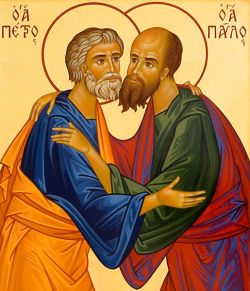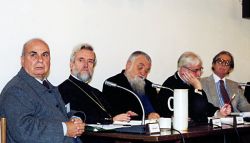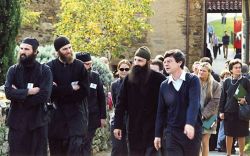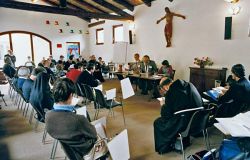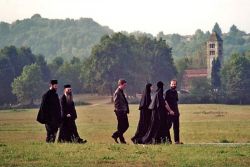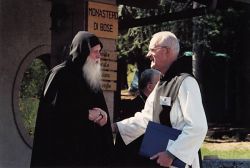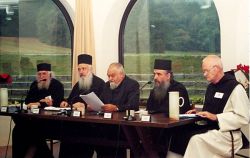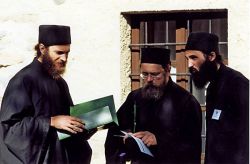Introduction to the Orthodox conferences
In Search of Shared Spiritual Sources: International Ecumenical Conferences on Orthodox Spirituality
The Experience of a Fraternal Encounter
Since 1993 for more than twenty years now, the Monastery of Bose in Italy, has been a meeting place for Christians from East and West wishing to discuss aspects of Christian spirituality. They are Christians belonging to the Orthodox, Reformed, Roman Catholic and Anglican churches, and these encounters have been and will continue to be essentially an occasion for listening to each other. “You have seen your brother, you have seen God” is a frequently quoted saying of the desert Fathers. One could paraphrase it and say “You have heard your brother (i.e. you are able to listen to him), you have heard God (i.e. you are then able to make room in your life for the word of God)”, for indeed, how can we say we love (and therefore we listen to, serve and follow) God whom we do not see, if we do not love our brother whom we do see? (1 Jn 5:20).
It is precisely this wish to listen to one’s neighbour – a foremost prerequisite for any dialogue – that motivates and drives these conferences on the history of Christian spirituality. They are intended as a service to all churches, as an occasion for joint study and mutual encounters, for investigating the spiritual wealth of the Eastern Church, those “authentic theological traditions of the Eastern Christians” which, as the II Vatican Council authoritatively notes, are “rooted in the Holy Scriptures … expressed in liturgical life … nourished by the living Apostolic tradition, by the writings of Fathers and ascetics from the East … aspiring to a correct approach to life , indeed to the full contemplation of Christian truth”.
The participation in these conferences of Orthodox, Roman Catholic and Reformed Christians underscores the precise practice of these encounters: let the other define himself and bring testimony of what he holds most dear. What lies at the heart of each specific Christian tradition is its own history of holiness, where the gifts of the Holy Spirit are manifest and become incarnate in a concrete manner and in a particular path, and through Grace come to bring sense and hope to all churches and to all mankind.
The initiative, made possible through the cooperation of Professor Nina Kautschwili of Bergamo University, soon came under the patronage of the Patriarchate of Moscow, thanks to the interest shown by Metropolitan Kyril of Smolensk and Kaliningrad, and later on by Ecumenical Patriarch Bartholomeos I. Ever since their inception, the Pontifical Council for Christian Unity welcomed these conferences and assured its efficient cooperation. Gradually, representatives of all Churches, Orthodox and Protestant, came to this initial Italian-Russian initiative, along with scholars and church personalities from other countries, such as France, Germany, Belgium, Great Britain, Greece, Romania, Bulgaria, Serbia, Czech Republic, Norway, Ukraine, Belarus, United States and Canada.
From the eighth conference onwards, the Russian section was flanked by a section on Byzantine spirituality. This joint approach proved to be particularly fruitful on account of the numerous cultural, spiritual, institutional inter-relationships which mark the history of Byzantine and Slav civilizations, and an occasion for a fraternal and open encounter on the actual state and vitality of these inter-relationships in the context present day ecumenical relations. Topics dealt with to this day combine the rich spiritual heritage of the Russian tradition with the study of Byzantine and Greek Fathers and of the Church in the first millennium: St Nikodemos the Athonite and the Philokalia / Forms of Russian Holiness (2000); St John Climacus and Mount Sinai / Ways of Russian Monasticism (2001); St Symeon the New Theologian and Constantinopolitan Monasticism / The Elders of Optina Monastery
(2002); The Desert of Gaza: Sts Barsanuphius, John and Dorotheos / The Great Moscow Council of 1917-1918 (2003); St Athanasius the Athonite and Monasticism on Mount Athos / The Jesus Prayer in 19th Century Russian Spirituality (2004); St John Damascene. A Church Father at the Emergence of Islam / Andreij Rublev and the Russian Icon (2005); St Nicolas Cabasilas and the Divine Liturgy / The Missionary Work of the Russian Orthodox Church (2006).The fifteenth edition brought with it a new formula: the two sections (the Byzantine and the Russian) centered around the same theme, with the intention to trace a common itinerary of the main aspects of the spiritual life that are at the core of the Orthodox tradition, whatever its peculiar culture. A fruitful confrontation with the western spiritual tradition and with questions posed by our contemporaries was also not forgotten. So far the following conferences have been organized in this manner: The transfigured Christ in the Orthodox spiritual tradition (2007); Spiritual paternity in the Orthodox tradition (2008); Spiritual struggle in the Orthodox tradition (2009).
Conference Proceedings are published annually, often translated in many languages, providing continuity for encounters and mutual knowledge, and at the same time broadening the horizons of all those who feel the imperative importance of a renewed approach to the sources of Christian spirituality. Let us now see why this search for common sources is so essential.
An Exchange of Gifts Made Possible
I thinking chiefly of the urgent need for a true spiritual life of prayer and for fraternal communion, which are indeed a gift from high above (Psalm 133) but also the fruit of a convergence towards one sole heart and one sole mind, of a synod (synodos) in the sense of a path on which we walk together with the other, each trying to render visible the spiritual gift he carries inside, his charism, placing it in the service of his brethren. It is precisely the true life of prayer and the concrete charity of one to the other that enables the monastery to be a sign, to dwell in the margin, in this loving detachment from the world, which is necessary if one is to pronounce a prophetic word for contemporary man.
I. First and foremost, prayer. I think I can say in all objectivity that the Orthodox East has been able to safeguard more forcefully and clearly than we in the West the unbreakable link between monastic vocation and prayer.
Pope John Paul II significantly reminds us that western monasticism could usefully draw from eastern monasticism the emulation of the self-effacement (kenosis) of the Word, the transfiguration in God’s image, in other words the deification, the renounciation (apotaghe), vigilance, compunction (penthos), peace (hesychia). All these can be attained through prayer. I would like to add some remarks taking into account the specificity of Russian monastic tradition, which can be for us a clear call and also a reason to hope amidst the difficulties of our contemporary age.
All the great monastic fathers lived at times of crisis. The great masters of Russian monasticism had a particular awareness of their smallness, of their near unworthiness next to the early Church Fathers, of their inadequacy in front of the same demands of monastic vocation. “I do not do anything worthwhile,” St Nil Sorskij liked to repeat in his letters. “Above all I devote myself to the study of the Holy Scriptures, of the commandements of our Lord as commented upon by the Fathers,” he wrote in his Letter to German.
St Ignatij Brianchaninov, in his Spiritual Instructions for contemporary monks, quotes a saying of Abba Sisoe the Great. To a disciple who saw himself constantly united with God, the Elder replied, “It is no big deal to be constantly with God in one’s thoughts, what is important is for a monk to feel and see himself as inferior to all creatures”.
Speaking of the prayer of the heart, as of the art entrusted to each monk, the venerable Seraphim of Sarov said, “Interior prayer on its own does not suffice. God looks into the heart and for this reason monks who do not unite exterior prayer with the interior one, are not monks”. “Words most true!” remarks St Ignatij Brianchaninov, “Monk means united; he who is not united in himself, he who is not yet unified, is not a monk, even if he lives in the remotest of monasteries…Unity of the person in itself cannot be attained in any other way than through attentive prayer, and above all through the Jesus prayer”.
But in the West also, when one repeats the invocation mens concordet voci, asking for a prayer in which the heart attaches itself to the lips, one expresses essentially the very same truth. At the occasion of one of the conferences at Bose, a great monk of the West, Dom André Louf, felt obliged to address those highly significant words of gratitude to the Orthodox monks: “In the fifties we had a very generous monastic life, but I think we had lost the vital link between exemplary adherence to rules and interiority, interior prayer. And then in our land of France, Fr André Scrima, visiting various monasteries, became an apostle of the Philokalia … A word of thanks therefore towards our Orthodox brethren; I believe that we had lost that link between exterior experience and interior presence … but I also think that it is through the Philokalia that we disovered that there is a tradition of Philokalia in the Latin tradition …”.
II. The epiphany of a monk’s interior life of prayer is the reward of coenobetic life, in the likeness of Trinitarian communion. Fr Spyridon, abbot of the Monastery of the Transfiguration of the Saviour at Nafpaktos, Greece, reminded us during the conference dedicated to St Nikodemos the Athonite and the Philokalia (2000), that the profound unity between interior prayer and eucharistic assembly, where the unity of the coenobetic body becomes manifest, is the key to interpret and truly comprehend the texts of the Philokalia: “For monks, the two are inseparable; we cannot separate the descent of the intellect into the heart from eucharistic and ecclesiastic life”.I believe it is very important that our contemporary communities rediscover synodality, as a path we walk together with different roles and functions, in common obedience to the revealed Word, the Gospel, which requires constant reconversion and whose rules or spiritual guidance are but a means. The great parable of the reflourishing of Russian Orthodox monastic life, the adversities experienced by the holy founders of monasteries, live through this tension. This is how the life of the Skete was born into St Nil Sorskij and his disciples. This is how the anchorite colonies on the Solovki Islands became the source of a renewed coenobetic life. The hesychast way of St Paisij brought about a profound movement of renaissance, marked by coenobetic life. In his wake we find the Elders of Optina and the works of St Ignatij Brianchaninov. Yet all of them are within a single and unique vocation.
We must be grateful to the Orthodox East, for being able to preserve this unity in plurality which is the hallmark of monasticism, not allowing the fragmentation of religious life which in the West has overshadowed the quest for the unicum necessarium. I believe that the lay dimension of Orthodox monasticism has played an importantg role, since it has ensured that monks have remained faithful to the intuition of the desert Fathers: to be a simple Christian presence in the Church. Naturally, a presence of different intensity in terms of prayer and ascesis, celibacy and coenobetic life, and yet at the same time each monk recognizing himself in the words of Pachomius describing himself and his brethren to the Patriarch of Alexandria:“We are but insignificant laymen, we are but poor laymen”.
III. It is my conviction that a third element emanates from this, an element which is theologically more important: the recovery of the eschatological dimension of monastic testimony, and consequently of Christian testimony. Monasticism should be a true and continuous invocation of the glorious coming of the Lord, reminding us that there is an invisible reality, which can attract because it is much more powerful than visible reality. Monks, genuinely trained through ascesis, must believe in this invisible reality, otherwise their presence becomes similar to that of salt without taste. According to St Basil the Great – whom we never forget – a monk’s task is to be “vigilant every day, every hour, every moment knowing that the Lord is coming”, always invoking His presence. It is the same conviction that I came across in a passage by St Bernard of Clairvaux: “Brethren, what you are asked to do and as monks you have vowed to undertake, is the most excellent way of prophesying. How must monks be prophets? By not seeing what is visible and by fixing their gaze on the invisible, by striving to attain what is in front of them, by living on faith alone (sola fide), by seeking things celestial. There was a time when prophets merited their name because they kept looking at the invisible reality, at Christ; your invisible reality however is the very Kingdom, it is the Lord in the glory of His coming” (Sermoni diversi 37, 6).This is why I am convinced that in both in town and country no place is unsuitable for monasticism. The true question is whether a monk knows how to shoulder the desert, whether he really knows how to rediscover the “hidden man of the heart” of whom speaks St Peter (1 Pt 3, 4), whether he knows how to safeguard the interior man, make him grow and become strong, as St Paul commands (2 Cor 4, 16). If monasticism is capable of achieving this, there will be men and women who will respond freely and out of love to this vocation, and who will know how to become in their turn spiritual fathers and mothers.
A monastic community does not live for itself alone, any more than it lives on itself. A community of monks lives on God’s mercy, and at the same time it is sent to the world and tries to be a sign of God’s love for mankind. If, particularly in the West, the need for authentic spiritual fatherhood is keenly felt, it is because in spite of the major scholarly and cultural development of Christianity, one often has to try hard to find shepherds capable above all of discernment, capable of being fathers in faith and not merely protagonists in the social sphere.
But this is precisely there that lies the terrain for a renewed dialogue between the Eastern and the Western Church, if they share openly their mutual experience and jointly rediscover the manner most comforming to the Gospel for meeting the challenges of modern culture and world.
Bose, January 2009
Enzo Bianchi, prior of Bose
For more information contact:
Conferences Secretariat
Monastery of Bose
I-13887 Magnano (BI)
Tel. +39 015.679.185
Fax +39 015.679.294
e-mail: This email address is being protected from spambots. You need JavaScript enabled to view it.
